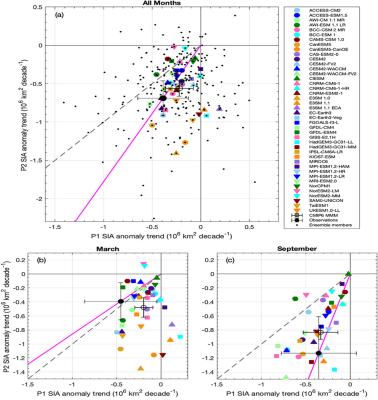Historical Arctic Amplification in CMIP6 models
While the CMIP6 multi-model mean captures the observed sea ice area (SIA) decline relatively well, an individual model’s ability to represent the acceleration in sea ice decline remains a challenge. Simulations of sea ice volume (SIV) show much larger spread and uncertainty than SIA; however, due to the limited availability of sea ice thickness data, these are not as well constrained by observations.
The study introduces an emergent constraint that relates trends in ocean heat transport (OHT) to those in Arctic sea ice cover during a warming climate. However, it acknowledges the need for further investigation due to data limitations in the CMIP6 archive. To reduce uncertainties associated with ice-ocean feedback, we propose a new model evaluation method involving the examination of OHT and its impact on sea ice decline.
This study evaluates the decline of Arctic sea ice in 42 models participating in phase 6 of the Coupled Model Intercomparison Project (CMIP6) historical simulations. The recently observed accelerated trend in sea ice decline is used as a benchmark to assess its representation in the models. The analysis shows that while the CMIP6 multimodel mean captures the observed sea ice area (SIA) decline relatively well, individual model simulations depict a wide range of biases and trends. The study finds that 17 out of 42 models and 37 out of the total 286 ensemble members reasonably capture the observed trends and acceleration in SIA decline. Additionally, the study introduces a new model evaluation method and explores the potential causes of the accelerated sea ice decline, linking it to ocean heat transport and ice growth. The findings highlight the need for better understanding and modeling of ice-ocean interactions, especially with respect to frazil ice growth. The analysis also indicates that a larger ensemble size increases the odds for a model to include at least one ensemble member skillfully representing the accelerated SIA trends.

